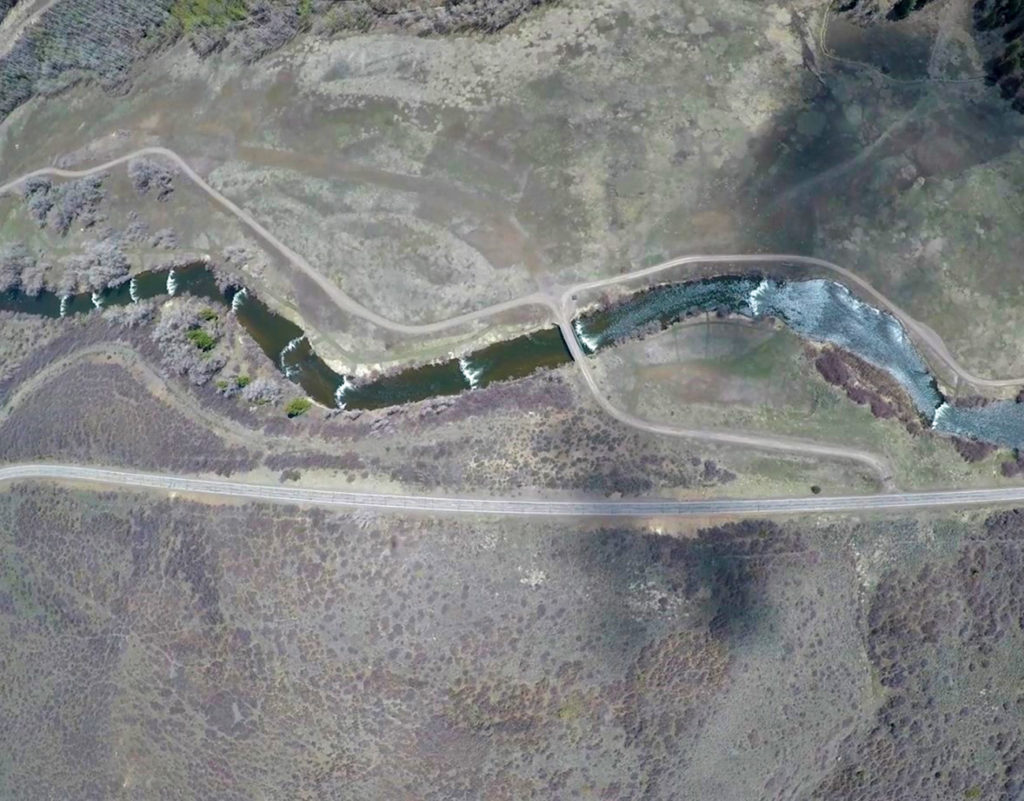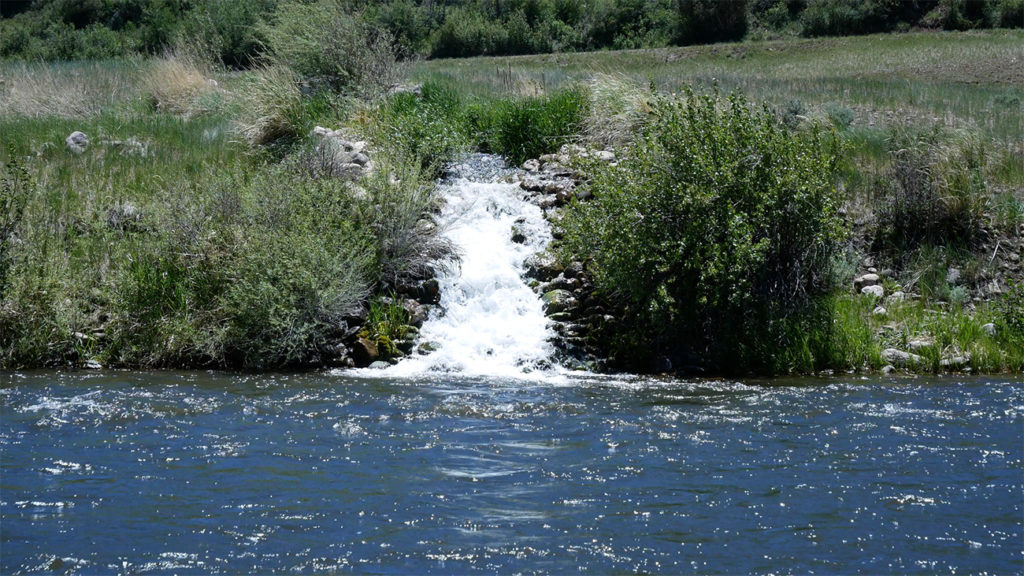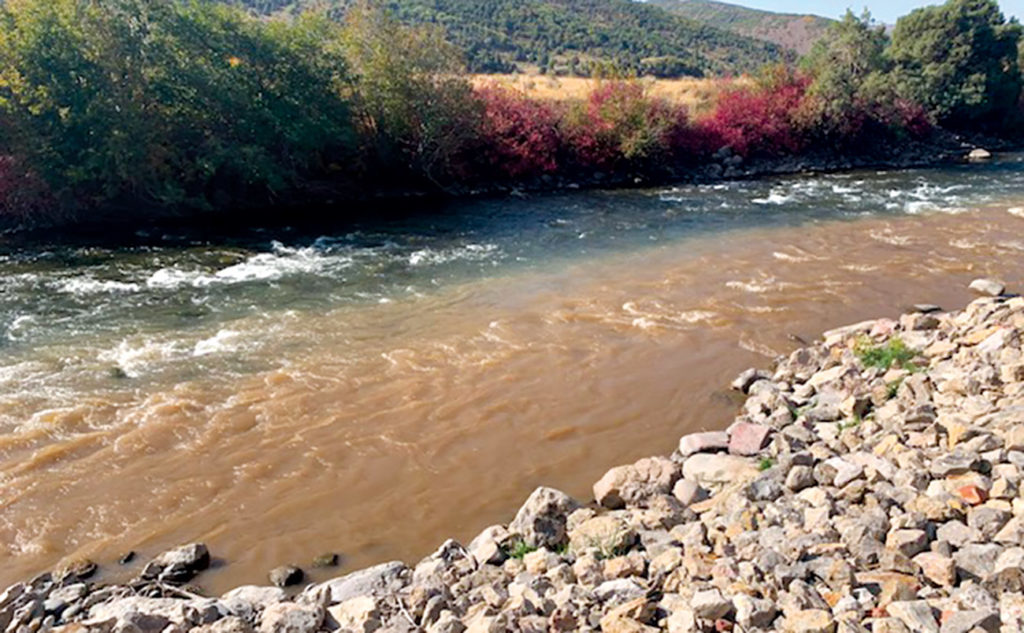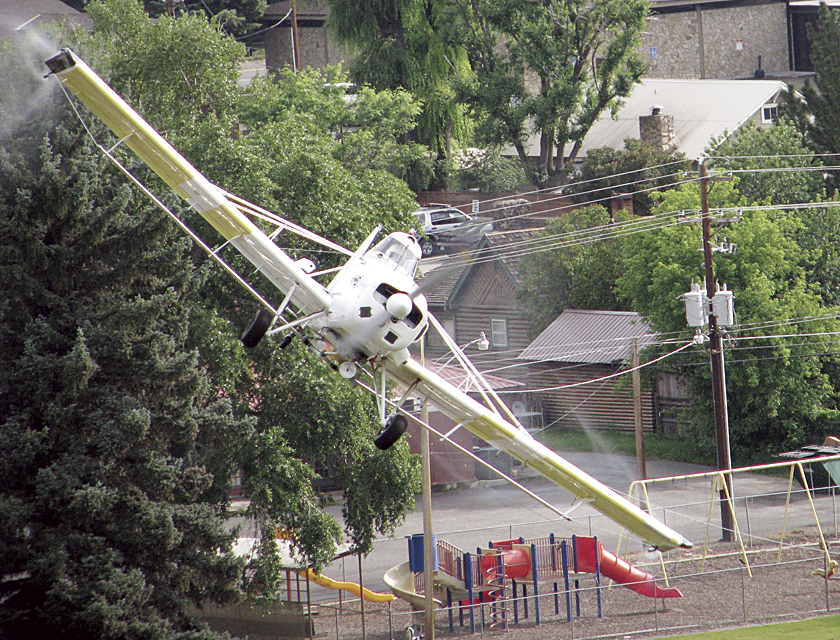Stakeholders have varying opinions about algae bloom’s origin
MEEKER | “It’s supposed to be a nice, wild experience, this is like Coney Island out here,” said Bob Regulski, expressing years worth of frustration over what he considers to be unnatural and detrimental changes to the White River, just upstream from his property, the Sleepy Cat Ranch.

Pictured are “habitat enhancements” that Sleepy Cat Ranch owner Bob Regulski believes contributed to the river’s algae problem | LUCAS TURNER
“The river has changed,” has been the connecting thread of Regulski’s own observations of the health of the watershed. “The whole geomorphology has changed,” he said, referencing developments that have occurred along the river in the last 10-plus years, notably the construction of “aquatic habitat enhancements” directly upstream from his own stretch of river property.
Documents shared with the HT detail the nature of said “habitat enhancements,” including an application for “Permit 12” from the U.S. Army Corps of Engineers, prepared on behalf of Elk Creek Ranch Homeowners association for work that would occur in the fall of 2020. Work which can most easily be described as excavation of six “pools” and subsequent construction of associated “tail-outs” and artificial streambank/shoreline or “lateral bars” along a designated stretch of the river just upstream from Sleepy Cat Ranch.
The permit application explains how excavating five-foot deep pools in the proposed project area would provide “more holding water” for adult trout, and better habitat for spawning fish in pool “tail-out” transition areas. Despite noting “Trout habitat within the reach can be characterized as fair to good,” the application describes a lack of sufficient pool depth as the “primary limiting factor” for overall habitat, hence the need for the pools.

Manmade dams above Sleepycat Ranch | LUCAS TURNER PHOTO 
Pond drainage along the upper White River | LUCAS TURNER PHOTO
The project, which was ultimately approved after jumping through various regulatory hurdles, was not the first of its kind in the area. In fact, last year’s river alterations were described as “relatively small” in scale and scope compared to similar work that happened in 2014 further up the river.
That was when Regulski first got involved, describing how excavation activities upstream “turned the river brown.” As noted in Part 1 of this series, the first major algae bloom noted in the HT’s reporting also happened in summer 2014, the same year the extensive “habitat enhancement” work occurred. “I’m talking miles of the river got changed,” said Regulski, who then initiated a lawsuit to stop the work, which he describes, among other terms, as “dredging.”
He further asserted that expert geomorphologists he consulted with at the time strongly advised against the proposed in-channel structures. For that reason and others, he thinks the pools “are fundamentally changing the river” and says they’ve done more harm than good by changing the river’s natural flow, slowing down/backing up water and ultimately contributing to the ongoing algae blooms in what could be a significant way. Potential hydrological and geomorphic changes aside, Regulski’s primary concern relating to algae has been related to streambed sediment mobilization, and “sediment plumes” in the river during 2020 and 2014 “dredging” work.

Sediment plumes in 2020 | COURTESY PHOTO
In an April 2020 letter from Colorado Parks and Wildlife to the Army Corps, CPW commented on the proposed pool excavation project, advising caution. The letter explained that any increase of nitrogen to the river would contribute to algae growth in the river, including from dredging, or digging in the streambed, stating “nutrient rich fine sediment currently in the streambed will likely be mobilized by construction activities.” Despite the warning, CPW agreed with the applicant’s proposed plan to mitigate the effects of sediment mobilization by “pulsing” work, stopping for 10-30 minutes as necessary whenever the sediment was extending further than “several hundred feet of its origin.” According to photos collected by Regulski, sediment plumes may have extended for thousands of feet, if not for multiple miles from their origin during 2020 excavation work. For this reason Regulski believes the contractor violated their permit, though he said no one will enforce the issue.
Generally speaking, a lack of oversight and enforcement of development on the upper White River was another underlying theme for Regulski, who despite recently subdividing lots on his own riverfront property for future development, said “all I want to do is leave the river alone.”
He added that despite believing in-channel stream development was a major problem, he believed other factors have been at play, specifically those which could be contributing excess nitrogen to the river, such as fish feeding/breeding or pond water draining into the river. He doesn’t believe, however, that spraying for mosquitos, (another hypothesized potential cause of algal growth) is really the issue.
Shawn Welder, President of the White River Alliance and landowner on the upper White River, contrasts the view of Bob Regulski with his own focus, bugs. More specifically, Welder points to the use of chemical pesticides as a potential key factor affecting algal blooms. That said, he wasn’t ready to designate the spraying of chemicals like permethrin as the sole, or even primary cause of algae bloom. Whatever the truth may be, Welder thinks addressing the use of indiscriminate pesticides is still worthwhile for improving the overall health of the watershed. “I use the term holistic health,” Welder said. “It’s simply, be proactive and try to get rid of things that are bad and promote things that are good,” he said, adding “and the permethrin is definitely bad on the river.”
His assertion stems from the fact that macroinvertebrate populations in the river naturally feed on algae. This means that an algae bloom may, in theory, be less severe in areas with healthy bug populations, as opposed to areas sprayed with permethrin where bugs would be killed. Though aerial spraying is a tradition and meant to control mosquito populations, whether it actually achieves that goal has been hotly debated.
Whatever the truth about aerial spraying may be, observations and sampling over the years have repeatedly shown a significant impact on bug populations in the river below Sleepy Cat. This could be contributing to the algae problem, or it could be a result of algae blooms. As noted in a January review of USGS study data, significant algal growth along the river substrate could negatively affect bug populations’ ability to reproduce and develop, contributing to a certain kind of “feedback loop.”
Noting how the use of permethrin near waterways has been banned in many other parts of the country and state including in Garfield County, Welder said, “We don’t understand the total impact of the use of permethrin on the White River,” adding that a closer look into case examples of rivers that banned the use of permethrin could be beneficial for the community. In the meantime White River Alliance members have taken time to advocate for the town to set an example for upriver landowners by changing its mosquito control program to something potentially more effective, like the use of larvicide instead of insecticide.
As for other potential causes of algae blooms, Welder didn’t place as much emphasis on the effects of human-caused streambed mobilization, hydrological changes to the river or even ponds, so long as those developments were built in a safe way that would make them far less likely impact the river. He also discouraged the idea that stream developments could be pointed out as a singular or primary cause of algae, given that he said algae blooms start up to 10 miles up the river from where those developments took place in 2020 and 2014.
He also pointed out that measurements of nitrate/nitrogen in the river had thus far been inconclusive in identifying a significant source of nitrogen entering the river.
Welder focused back on two points, being cautious about making specific conclusions, while also acknowledging the specific ways in which we as humans impact the health of our environment. As far as the health of the river goes, he reiterated his “holistic health” approach, describing how anything and everything that could be contributing to negative impacts on the health of the river should be addressed.
As part of this ongoing series we are examining algae blooms in other states in the U.S. Rockies like Montana. We will also be speaking with more river experts, government officials, data scientists and more.
If you have any questions about this reporting, suggestions, or otherwise please email[email protected]
This reporting is partially funded by a grant from the CU Water Desk.
By LUCAS TURNER | [email protected]om




















